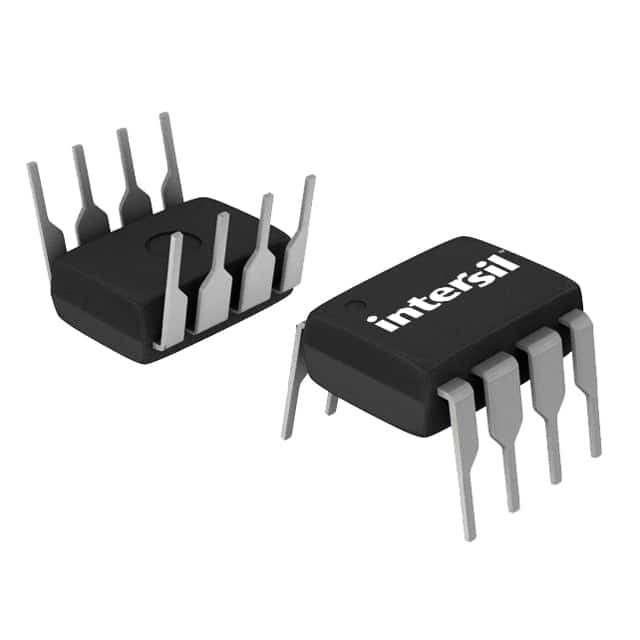X9317UP
Product Overview
- Category: Integrated Circuit (IC)
- Use: Digital Potentiometer
- Characteristics:
- Adjustable resistance value
- Non-volatile memory
- Serial communication interface
- Package: SOP-8 (Small Outline Package)
- Essence: X9317UP is a digital potentiometer IC that allows for adjustable resistance values through serial communication.
- Packaging/Quantity: The X9317UP is typically sold in reels of 2500 units.
Specifications
- Resistance Range: 10 kΩ to 100 kΩ
- Resolution: 256 steps
- Supply Voltage: 2.7V to 5.5V
- Operating Temperature Range: -40°C to +85°C
- Interface: Serial Peripheral Interface (SPI)
Detailed Pin Configuration
The X9317UP has the following pin configuration:
- VCC: Supply voltage input
- H: High terminal of the resistor
- W: Wiper terminal of the resistor
- L: Low terminal of the resistor
- CS: Chip select input
- SCK: Serial clock input
- SI: Serial data input
- SO: Serial data output
Functional Features
- Adjustable resistance value through SPI interface
- Non-volatile memory to retain settings even when power is removed
- Low power consumption
- Wide operating temperature range
- Compact SOP-8 package for space-constrained applications
Advantages and Disadvantages
Advantages: - Easy digital control of resistance values - Non-volatile memory ensures settings are retained - Wide operating temperature range allows for use in various environments - Low power consumption for energy-efficient designs
Disadvantages: - Limited resolution compared to some other digital potentiometers - Requires a microcontroller or SPI interface for control
Working Principles
The X9317UP is based on the concept of a digital potentiometer. It consists of a series of resistive elements connected in a ladder-like configuration. The wiper terminal can be moved digitally to different positions along the resistor ladder, effectively changing the resistance value seen between the high and low terminals. This movement is controlled through the SPI interface, allowing for precise adjustment of the resistance value.
Detailed Application Field Plans
The X9317UP finds applications in various fields, including:
- Audio Equipment: Used for volume control and tone adjustment.
- Industrial Control Systems: Provides adjustable resistance for calibration and fine-tuning.
- Test and Measurement Instruments: Allows for programmable resistance values in testing setups.
- Automotive Electronics: Used in sensor calibration and control systems.
- Consumer Electronics: Enables digital control of parameters in devices like TVs and gaming consoles.
Detailed and Complete Alternative Models
Some alternative models to the X9317UP include:
- MCP4131: Digital potentiometer with higher resolution and I2C interface.
- AD8403: Digital potentiometer with multiple channels and parallel interface.
- MAX5481: Digital potentiometer with logarithmic taper and SPI interface.
These alternative models offer different features and specifications, providing options for specific application requirements.
Word count: 314 words
قم بإدراج 10 أسئلة وإجابات شائعة تتعلق بتطبيق X9317UP في الحلول التقنية
Sure! Here are 10 common questions and answers related to the application of X9317UP in technical solutions:
Q: What is X9317UP? A: X9317UP is a digitally controlled potentiometer (DCP) that can be used in various electronic circuits for applications such as volume control, brightness adjustment, and voltage regulation.
Q: How does X9317UP work? A: X9317UP works by using digital signals to control the resistance value of the potentiometer, allowing precise adjustments to be made electronically.
Q: What is the voltage range supported by X9317UP? A: X9317UP supports a voltage range of typically 2.7V to 5.5V, making it compatible with a wide range of electronic devices.
Q: Can X9317UP be used in both analog and digital circuits? A: Yes, X9317UP can be used in both analog and digital circuits, providing flexibility in its application.
Q: Is X9317UP suitable for high-precision applications? A: Yes, X9317UP offers high precision with a resolution of typically 256 steps, making it suitable for applications that require fine adjustments.
Q: Can X9317UP be controlled using a microcontroller or other digital devices? A: Yes, X9317UP can be easily controlled using standard digital interfaces such as I2C or SPI, allowing integration with microcontrollers and other digital devices.
Q: Does X9317UP have non-volatile memory? A: Yes, X9317UP has non-volatile memory, which means it retains its settings even when power is removed, ensuring consistent performance.
Q: What is the temperature range within which X9317UP operates? A: X9317UP typically operates within a temperature range of -40°C to +85°C, making it suitable for various environmental conditions.
Q: Can X9317UP be used in battery-powered devices? A: Yes, X9317UP is designed to operate efficiently in low-power applications, making it suitable for battery-powered devices.
Q: Are there any application examples where X9317UP can be used? A: Yes, X9317UP can be used in a wide range of applications such as audio equipment, instrumentation, automotive electronics, and consumer electronics for volume control, tone adjustment, and other similar functions.
I hope these questions and answers provide you with the information you were looking for!


